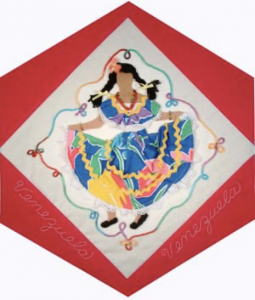Venezuela

The Block
A colourfully costumed dancer created by Ana Gil takes centre stage on this block, a reflection of Venezuelans’ passion for music and dance. The bright bold colours of the shawl and full skirt reveal the exuberant nature of the people. Paired with a white blouse, this type of skirt allows a full range of movement and is typical of the clothing worn during the lively, fast-paced Joropo––the national dance, and one of many that children learn at an early age. A delicate orchid, symbolic of friendship, and ribbons add the festive finishing touches to the woman’s hair. Variegated soutache cording flows in an undulating frame around her and evokes images of dancers swaying to the rhythmic sounds of calypso music.
Cultural Profile
Venezuela, meaning ‘Little Venice’, was named by a Spanish explorer who, upon seeing palefitos (houses built on stilts) along the region’s shoreline, was reminded of Venice, Italy. A country of striking beauty, Venezuela is home to a large biodiversity. Here you will find Angel Falls, the world’s highest waterfall, the Anaconda, the longest snake, and numerous table mountains or tepuys, that are some of the oldest rock formations on earth.
The majority of Venezuelans are mestizo, or mixed race, while indigenous people, some of whom maintain their traditional way of life, make up only two percent of the population. The official language is Spanish although over 30 Amerindian languages still survive. Indigenous groups have retained their traditional crafts, such as the mochila crochet bags of the Wayuu, the coil baskets of the Warao or the items made by the Anu from the enea fiber.
Venezuelans, famous for their easy-going nature and fun-loving spirit, often speak less formally than people in other Spanish-speaking countries and use affectionate nicknames for people they do not know well. These names are often given based on appearance and can sometimes seem rude to those not familiar with the custom. Friends are very important to Venezuelans but family, with whom they spend a great deal of their time, is at the centre of their lives. The elderly are respected and abuelitos, the grandparents, are often very involved in the care of children.
Historically, the economy depended largely on cocoa and coffee but now, as the country is home to the largest oil reserves in the world, the economy is built upon the country’s rich petroleum and mineral resources. The country is known for its spinning, weaving, clay pottery, jewelry, and gold and silver decorated glassware. Handicrafts made in the country include ceramics, hammock weaving, basket weaving, and items made of seashells. The town of Tintorero is particularly well-known for its craft fair where artisans from all over South and Central America meet. However, its most distinctive cultural outlet is music, a blend of European, African and indigenous rhythms.
Carnival, one of the nation’s liveliest holidays, is celebrated with parades and street parties in which people in intricate costumes dance to lively calypso music, often performing the joropo. The genre is usually played with harp, cuatro guitar, the bandola, a pear-shaped mandolin, and the maracas.
Venezuelans are listed in immigration records as coming to Canada since 1974. They come to further their education or to seek job opportunities, and sometimes for political reasons, bringing with them a variety of skills, viewpoints and ideas. As of 2011, there were over 18,000 Venezuelans living in Canada.
Sponsor: Maryelle Tétreault, en mémoire de Pierrette et Renée Tétreault
